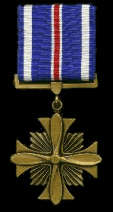
Distinguished
Flying Cross
![]()

| Awarded
pursuant to Section 3749 of title 10, United States Code, “Distinguished
flying cross: award; limitations,” March 1995 (U.S. Army Service
members), Section 6245 of title 10, United States Code, “Distinguished
flying cross: award; limitations,” March 1995 (U.S. Navy and U.S. Marine
Corps Service members), Section 8749 of title 10, United States Code,
“Distinguished flying cross: award; limitations,” March 1995 (U.S. Air
Force Service members), and Section 492a, 14 U.S.C. (reference (nnn))
(U.S. Coast Guard Service members). The Distinguished FIying Cross maybe
awarded to any persons who, after April 6, 1917, while serving in any
capacity with the United States Armed Forces, distinguish themselves by
heroism or extraordinary achievement while participating in aerial flight.
In the Navy and USMC, the performance of an act of heroism after April, 1974, shall be recognized by a “V” device worn on the suspension and service ribbon of the medal. |
| BACKGROUND |
| The
Distinguished Flying Cross was established in the Air Corps Act (Act of
Congress, 2 July 1926, Public Law No. 446, 69th Congress). This act
provided for award "to any person, while serving in any capacity with
the Air Corps of the Army of the United States, including the National
Guard and the Organized Reserves, or with the United States Navy, since
the 6th day of April 1917, has distinguished, or who, after the approval
of this Act, distinguishes himself by heroism or extraordinary achievement
while participating in an aerial flight."
Initial awards of the Distinguished Flying Cross were made to persons who made record breaking long distance and endurance flights and who set altitude records. The Secretary of War authorized the first Distinguished Flying Cross to Captain Charles A. Lindbergh in a letter dated 31 May 1927. With the support of the Secretary of War, the Wright Brothers retroactively received the Distinguished Flying Cross. This award required a special Act of Congress, since the law precluded award to civilians. |